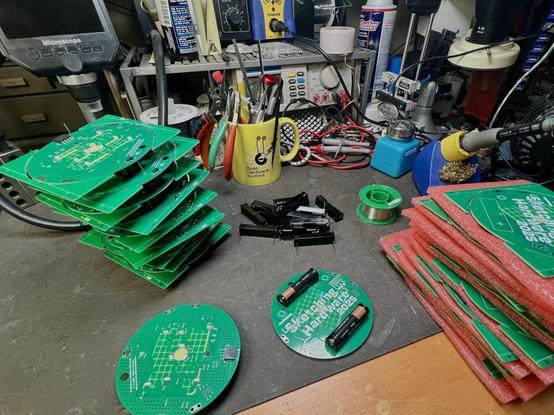I designed another PCB... Small preview without revealing what it will be. It'll arrive mid January, though.
They will be manufactured by @aislerhq again, using the 20% December discount for using their #KiCad plugin.
It'll have the option to use an AVR DA compatible #microcontroller or a #tinyAVR one - I added options for both that I have in stock (AVR32DA32 and ATtiny814). Since it won't use many pins, I could have used smaller variants, too.
#AVR #AVRDA #ATtiny #pcbdesign #kicad #aisler #pcbdesign
#AVR
My latest piece in Machina Speculatrix - #programming #AVR 0-series #microcontrollers via UPDI (Medium sub required).
#maker #tech #technology #makers #computer #electronics #homebrew #hobby
Aviation weather for Alverca Air Base airport in Vila Franca de Xira area (Portugal) is “LPAR 281800Z 34004KT 9999 FEW035 13/08 Q1022” : See what it means on https://www.bigorre.org/aero/meteo/lpar/en #alvercaairbaseairport #airport #vilafrancadexira #portugal #lpar #avr #metar #aviation #aviationweather #avgeek vl
#AntiAKW Don’t Nuke the #Climate: Kugelhaufenreaktor #Jülich – eine unrunde Sache
Kugelhaufenreaktoren waren mal der letzte Schrei. Doch die Technologie ist gescheitert. Beispiel: der #AVR in Jülich. Grad mal 27 % der Betriebskosten konnte er während der verhältnismäßig wenigen Jahre seiner Laufzeit aus dem Stromerlös decken, den Rest zahlte die öffentliche Hand. 1/3
Geschafft. Wieder mal ein altes LAN-Kabel ausgeschlachtet, um daraus ein Kabel für eins meiner Projekte zu bauen. Diesmal ein Adapterkabel, um einen USBtinyISP #AVR #Programmer mit dem kleinen Breakout-Board für DIP-8 ATtinys zu verbinden. Jetzt kann ich relativ problemlos Kleinkram auf diese winzigen Controller laden :neocat_hyper:
New AVRPascal IDE 3.4 is available! Now including improved support for floating-point (IEE-754) and fixed-point (Q16.16) numbers.
Get the free IDE & UnoLib (Pascal for Arduino) here: https://akarwowski.pl/index.php?page=electronics&lang=en
Trying to make it easier to play with an SMD microcontroller. New article on Machina Speculatrix (for subscribers).
https://mspeculatrix.substack.com/p/creating-a-dev-board-for-an-atmega
#electronics #maker #microcontroller #AVR #tech #technology #PCB
This is how I go about writing #code for #AVR #microcontrollers. (For subscribers).
https://mspeculatrix.substack.com/p/avr-programming-a-dev-environment
#tech #technology #maker #computer #computer #programming #coding #atmega
I wanted to try out a few new things. So, I designed a development board for the AVR DA #microcontroller, the 32 pin #TQFP looked like something I'd be able to hand solder. I really like #UPDI from the ATtiny814. This is the result, my first four layer boards, first time with logos and an image. The image of #Frieren was a bit too small, though. Manufactured by @aislerhq again.
#AVRDA #AVR #devboard #pcbdesign #soldering #KiCad #Aisler #diyelectronics #developmentboard
Еще один самодельный компьютер. Coolsystem — Часть 1
Сегодня мы будем делать еще один восьмибитный компьютер. Да, я еще не наигрался со всеми этими штуками. Coolsystem - идея компьютера, сочетающего в себе идеи о защищенной среде выполнения (причем в очень-очень специфичном варианте) и способного запускать готовый софт для восьмибитных персоналок 80-х годов. Также он может использоваться для изучения основ схемотехники, своего рода учебный компьютер.
https://habr.com/ru/companies/diy_fest/articles/961420/
#avr #8_бит #хочется_странного #самодельный_компьютер #мыши #самодельная_клавитура #zx_spectrum #вектор_06ц #ретро
Finding myself increasing drawn towards the #AVR 0-series #microcontrollers, especially the small but capable ATtiny1604. I'm toying with the idea of a breakout board for it. Should I do it? It puts the port pins in a logical order and adds a decoupling cap and UPDI interface.
🌘 ATmega88 微控制器前面板啟動
➤ 親手為 ATmega88 注入生命:復古前面板啟動實踐
✤ https://www.linusakesson.net/hardware/frontpanel/index.php
作者重現了早期電腦前面板手動輸入程式碼以啟動微控制器(ATmega88)的歷史過程。藉由自製前面板,他成功將少量程式碼寫入晶片,並讓 LED 燈閃爍,親身體驗了從無到有創造電腦生命力的感動。文章也探討了實現過程中的技術細節、限制及未來擴充的可能性。
+ 這真是太酷了!我一直對早期電腦的操作方式感到好奇,能親手重現這種感覺一定很棒。我打算自己也來試試看!
+ 作者對於硬體細節的深入探討非常有價值,特別是關於命令暫存器和二極體應用的部分,解決了我對類似專案可能遇到的難題。
#硬體 #微控制器 #AVR #啟動流程
Aviation weather for Alverca Air Base airport in Vila Franca de Xira area (Portugal) is “LPAR 241000Z 25009KT 9999 FEW015 BKN022 24/18 Q1018” : See what it means on https://www.bigorre.org/aero/meteo/lpar/en #vilafrancadexira #portugal #alvercaairbaseairport #lpar #avr #metar #aviation #aviationweather #avgeek #airport vl
It took a while to gather enough information on how to use an Arduino as an ISP to program any other AVR chip. The documentation in the maker world is very loose and in many corners vague indeed.
I've put this together as a quick technical reference on using an Arduino to program bare metal AVR: https://blog.soch.cc/programming-avr-chips-with-arduino/
#arduino #avr #atmel #microchip #microcontroller #embeddedprogramming
Finishing up the first ever electronic badge for our Sketching In Hardware conference (the 18th!)
They just need battery holders soldered & programming. A simple but fun design. Designed w/ @Leeborg #badgelife #attiny #avr #sketching2025 #sketchinginhardware
Na toll:
@base lehnt #BUND-Antrag auf Aussetzung der sofortigen #Vollziehung der #Beförderungsgenehmigung ab
Das BASE hat am 02.09.2025 einen Antrag des BUND #NRW e.V. auf Aussetzung der sofortigen Vollziehung der am 25.08.2025 erteilten Beförderungsgenehmigung der #AVR-#Brennelemente von #Jülich nach #Ahaus abgelehnt.
(...)
Made a little morse serial transmitter with my new #arduino 😄
It decodes button presses in real time and transmits the character with UART. The 'words per minute' is currently hardcoded, so on-offs need to be somewhat fast (for me anyways).
The code is here, written in AVR C. Reviews welcome!
https://codeberg.org/some/arduino-uno-projects/src/branch/main/morse_transmitter/morse_transmitter.c
vm5277, пример компиляции для AVR
Пишем один код - собираем на разные 8 бит МК! https://vm5277.ru- это универсальное решение для embedded-разработки, которое позволяет сократить время создания прошивки для 8 бит микроконтроллеров в разы. Как это работает: Пишешь код на Java подобном языке (чистое ООП, без головной боли с указателями и не читабельным кодом) Компилятор автоматически генерирует оптимизированный ассемблерный код под выбранную платформу Код работает поверх легковесной RTOS, написанной на ассемблере для максимальной производительности Ассемблер-сборщик финализирует проект в бинарный файл прошивки
here's a real chiptune: Fly Me to the Moon by Bart Howard, arranged for ATtiny85 microcontroller by PROTODOME, 2020.
This was recorded from a tiny 8-pin micro-controller powered by a coin cell battery.







